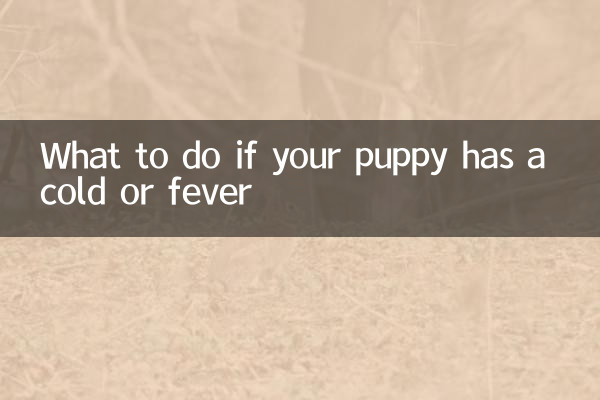What to do if your puppy has a cold or fever
Recently, pet health issues have become one of the hot topics on the Internet, especially how to deal with colds and fevers in puppies, which has attracted the attention of a large number of pet owners. The following are authoritative answers and practical suggestions on puppy colds and fevers in the past 10 days to help you scientifically care for sick puppies.
1. Common symptoms of cold and fever in puppies

Puppies have weak immunity and often show symptoms of colds and fevers. Here is a summary of common symptoms:
| symptom | Specific performance |
|---|---|
| Increased body temperature | The normal body temperature of puppies is 38-39°C. If it exceeds 39.5°C, you need to be vigilant. |
| listless | Decreased activity, lethargy, loss of interest in toys |
| decreased appetite | Refusing to eat or significantly reducing food intake |
| respiratory symptoms | Coughing, sneezing, runny nose (clear or purulent nasal discharge) |
| Other performance | Increased eye discharge and mild diarrhea |
2. Emergency treatment measures for puppies with cold and fever
If you find that your puppy has the above symptoms, you can take the following home care methods:
| step | Operating Instructions | Things to note |
|---|---|---|
| Body temperature monitoring | Use a pet-specific thermometer to measure rectal temperature | Avoid using human fever-reducing medications |
| physical cooling | Wipe foot pads, ear pinnae, and groin with warm water | The water temperature should not be too cold |
| hydration | Provide warm water or dilute pet electrolyte solution | Feed small amounts frequently |
| environmental adjustment | Keep the room temperature at around 25°C and avoid direct cold air blowing | The use of pet electric blankets requires supervision |
3. Warning signs that medical treatment is necessary
When puppies appear to have the following conditions, they should be sent to the hospital for treatment immediately:
1. Body temperature continues to exceed 40℃ for more than 2 hours
2. Complete refusal to eat for more than 12 hours
3. Vomiting or severe diarrhea occurs
4. Shortness of breath (more than 40 breaths per minute)
5. Pale or cyanotic gums
6. Convulsions or confusion
4. Routine veterinary treatment plan
According to the latest pet medical data on the Internet, the typical treatment plans for puppies with colds and fevers in regular pet hospitals are as follows:
| Treatment | Specific content | Course of treatment |
|---|---|---|
| antibiotic treatment | Amoxicillin, clavulanate potassium and other pet-specific antibiotics | 5-7 days |
| Reduce fever and relieve pain | Meloxicam and other NSAIDs | No more than 3 days |
| nutritional support | Intravenous fluid or nutritional cream supplementation | It depends on the situation |
| aerosol treatment | For severe respiratory symptoms | 3-5 days |
5. Preventive measures
According to a recent pet health survey, taking the following precautions can reduce your puppy's risk of disease:
1.Vaccination: Complete canine distemper, parainfluenza and other core vaccine immunization procedures on time
2.environmental management: Keep the breeding environment dry and ventilated, and disinfect regularly
3.temperature control: Keep warm when the seasons change and avoid direct air-conditioning blowing
4.Nutritionally balanced: Choose high-quality staple food suitable for the development stage of puppies
5.social management: Avoid contact with strange dogs before vaccination is completed
6. Special reminder
The method of "humans using cold medicine to treat dogs" that has recently been circulated on the Internet is extremely risky. Common human drugs such as acetaminophen can be fatally toxic to dogs, so be sure to follow these guidelines:
1. All medicines must be used under the guidance of a veterinarian
2. Strictly control the dosage and calculate it accurately according to body weight
3. Puppies of different breeds may have specific reactions
4. Record medication time, dosage and response
With scientific care and timely medical treatment, most puppies can recover smoothly from colds and fevers. It is recommended that pet owners learn basic pet first aid knowledge and save the 24-hour pet emergency phone number in case of emergency.

check the details

check the details